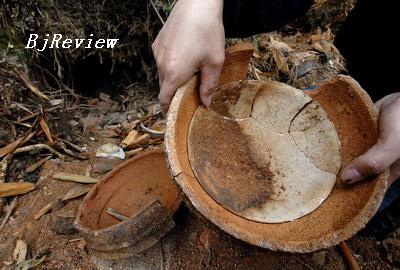A television documentary and better transportation have brought illegal treasure hunters to Minqing County with devastating results for the region's ancient kilns.
By JING XIAOLEI
In Yiyou Village, Minqing County in south China's Fujian Province ancient ceramic bowls, kettles and cups litter the ground. The ancient treasures are relics from the Song and Yuan dynasties and date back almost a thousand years.
Villagers had lived in peace with the relics beneath their feet for many years, although the proliferation of them left a lack of land to grow crops on. That peaceful coexistence ended one day with the arrival of a film crew from China Central Television (CCTV), making a travel program. The program alerted people across China to the village's hidden treasure, and soon illegal treasure hunters began to descend.
These plundering diggers targeted areas where trees did not grow or where plants were sparse with their picks and hoes. They took away intact ceramics and threw broken scraps away, said villager Lin Side.
"The ancient kilns in Minqing became much more famous after the television program was broadcast. Many came to visit them, but there were also some who came with a bad purpose," said Lin Hua, a member of the villagers' committee.
"Such cases had happened occasionally in the past, but now the illegal excavation was organized and sometimes they even brought professional detection and excavation tools."
Critical situation
Ascending the hills around the village, many holes can be seen by the side of the path surrounded by ceramic scraps. There was once a kiln here as big as 200 square meters, and the area is covered with ceramic scraps. "This used to be well preserved but now it is ravaged," Lin noted.
In 2004, a valuable old kiln that experts consider rare in the country was discovered in Yiyou Village. Now the kiln lies partially damaged and could collapse completely if nothing is done to protect it.
Aside from illegal digging, the unlawful purchase of ancient porcelain has added to the damage to the kilns.
The main income source of local villagers comes from growing oranges, which do not sell well. The value of porcelain makes its collection and sale attractive, even though it is illegal.
Locals often sell porcelain finds to passing tourists with the price ranging from dozens to thousands of yuan. One local young villager said that many households in his village sold porcelain.
But according to a local official Lin Xian, most of the buyers are non-natives who come from northeast China.
Quite unique
Minqing County has long enjoyed the reputation of being a rich land for porcelain production. In 1985, Chinese pottery and ceramics expert Feng Xianming traveled to Minqing County to identify kilns dating back to the Song and Yuan dynasties.
In Dongqiao town alone, there are more than 20 hills where some 100 kilns can be found.
"It was not rare to see such large-scale kiln sites back in the Song and Yuan dynasties," said Lin Yuexian, the curator of the museum in Minqing.
Minqing was one of the most important places for the production of blue-and-white porcelain in ancient China, added Lin.
The kiln stoves in Minqing were quite unique as they were lined up along the hillside and took the shape of a dragon, which gave the area's kilns the name of dragon kiln. In 2004, a 140-meter-long dragon kiln was found in Yiyou Village.
Experts say that the ceramics of Minqing were mostly sold to Japan and Southeast Asia. In 1991, the Fujian Provincial Government listed the kilns in Minqing as a province-level cultural relic site.
Nevertheless the old kiln site was not kept in good condition. The museum in Minqing had only two people to take care of all the cultural relic protection work in the county with an annual budget of merely 20,000 yuan ($2,750), according to museum curator Feng Xianming.
On the one hand, the kiln relics cover a vast area and are exposed to the open air, so it takes much work to protect them; on the other hand, there is scant awareness of cultural heritage preservation among the villagers. In the past the kilns were kept in good condition because of poor transportation to the region. Nowadays, as more roads have been built, the kilns face a growing threat.
"It's a critical situation for us that there's a heating trend for relic collection. Illegal excavation, and the trade between villagers and relic dealers have brought the situation to a critical level," noted Lin.
For the present the county has already formed patrol teams to guard the kiln relics, and awareness of cultural heritage protection has been boosted in the area through education.
The general environment for the protection of cultural relics in China has been improving in recent years. China has already participated in four international treaties for the preservation of cultural relics. The Law on Cultural Relics Protection was revised in October 2002 to institute regulations on the transfer and exchange of cultural relics for the first time.
But according to Gan Mantang, a sociologist from Fujian University, the Minqing case is a miniature of the situation of the nation's cultural relic protection in rural areas. A comprehensive system is needed to shelter these non-renewable cultural treasures, said Gan.
The government should increase investment and manpower to preserve relics and punish those who cause damage to them. People should raise their level of heritage protection awareness as well. Experts should also develop a complete and sound protection plan, he added.
(Beijing Review January 7, 2008)


